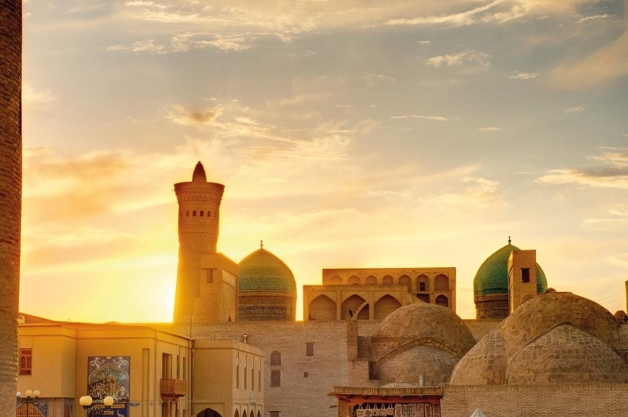Sights & Landmarks of Bukhara, Uzbekistan
How many days do you need in Bukhara? Two are recommended for a full exploration at a calm pace. The first - is acquainted with the city monuments. The second is to visit the shrines and the palace in the vicinity.
What are we looking at here? The old and holy city of the Islamic world, where ancient mosques, mausoleums, madrasas are located, has no analogs. Here is the architecture of the pagan epoch and the late Middle Ages, the influence of the Samanids, Karakhanids, Timurids, and Sheibanids. The city itself existed before our era.
The density of the location - 140 monuments of interest, allows us to call it a museum city. The attractions of the historical center are located within walking distance, so excursions in Bukhara are on foot. The world community has appreciated the treasury of antiquity, including the historical center of Bukhara on the UNESCO World Heritage List.
Every step through the Ark fortress - citadel, where the winter emirs’ residence was located, is like a procession through the everyday life of privileged persons and ordinary people. Every component of their household and palace ceremonies is presented here.
The Lyabi-Hauz architectural complex on Bakhoutdin Naqshbandi Street can be called the heart of the town – a scattering of medieval madrasahs encircling the pond in the center of the composition are dearly loved by both tourists and citizens. There are hotels, restaurants of national cuisine, tea & coffee houses, craft, and souvenir shop. During the day and in the evening, it is especially crowded here. It attracts guests who prefer to be in the epicenter of events. At night and in the morning, you can spend a pleasant time here in peace, peacefully watching the ducks swimming.
Its quite narrow streets, whose appearance has remained unchanged despite the passage of time, the true spirit of the East is felt in the monumental madrasas. The beauty and grandeur of architecture are not only in its scale. It is in detail they tell the true story of their era.
The damage was not caused by time or even natural factors, among which the proximity of the desert has a negative impact. The city suffered the most during the Mongol invasion led by Genghis Khan. He left no stone unturned in the conquered cities.
Surviving monuments of the pre - Mongol period:
• Samanid Mausoleum
• Kalyan Minaret
• Magoki-Attori Mosque
• Namazgah Suburban Mosque
Before the attack of Genghis Khan, the 47-meter Kalyan minaret, built by the Karakhanid dynasty in the 12th century, served practical purposes – a call for prayer, and a landmark-a beacon for traveling caravans and pilgrims. It was the tallest minaret in Central Asia at that time and was supposed to perpetuate the name of the Karakhanids in the memory of descendants. But after surviving the raid, the minaret became a symbol of the city, its inflexibility, and faith in rebirth.
The mausoleum of the Samanids on Ashrafi Street is an amazing monument of the 9th century, the tomb of the legendary Ismail Samani, which made a tremendous contribution to the development and prosperity of the city. Zoroastrian motifs can be traced in the architecture and decor of the mausoleum – pagan elements symbolizing the elements are visible in the ornate patterns. Similar interlacing in Uzbekistan can be seen only at the Magoki-Attori mosque, which is a contemporary of the tomb of the Samanids. It is noteworthy that the mosque itself was built on the site of the former temple of the Moon. Such non-standardness is of great interest to researchers.
Not far from the tomb of the Samanids is the mausoleum of Chashma-Ayub, where the Water Museum is now located. It is intended to emphasize the sacred status of water in the city, where every kilometer had to be won for life by hard human labor from the boundless sands of Kyzylkum. There is a holy spring on the territory. Legends connect him with the biblical Job. According to legend, the stream broke through the earth after his prayer and a blow with a staff.
Bukhara tours will tell and show the contribution of the Timurids to the heritage and improvement of the city. This dynasty not only transformed the mausoleum of Chashma-Ayub into the kind that we are now seeing. The Timurids presented the Kalyan minaret with the mosque of the same name, thanks to which a whole complex began to form, and Tamerlane's grandson Ulugbek built one of his three madrassas here to open the light of knowledge.
It is impossible to evaluate Central Asian architecture without mentioning the Sheibanid and Ashtarkhanid dynasties ruling in the 16th and 17th centuries. They built new madrassas and mosques. The Toki-Zargaron and Telpak-Furushon trading domes, which are still operating today, belong to their era. Here craftsmen who inherited the technology of their ancestors sell gold-embroidered masterpieces and jewelry, household items made of wood with carvings, and metal with coinage. Another surviving active attraction that conveys the flavor of antiquity – the Bozori Cord hammam continues to receive visitors seeking purification of the body and spirit.
Landmarks of Bukhara, Uzbekistan
Architectural complexes of Bukhara
The Ark Citadel on Bukhara's Registan Square is a residence of the emirs, a fortress that has personified the very principle of power for a millennium and a half. Residents hiding from the massacre of Genghis Khan's invaders sought shelter in its 20-meter walls. Now the Ark is open to everyone, and during the coronation, hall tourists are happy to take pictures on the Khan's throne.
The Bolo-Hauze complex with the former cathedral Friday mosque and pond-house is located on the Registan Square of Bukhara in 1712, opposite the Ark fortress. The patron of the richly decorated building was the mother of Abu al-Fayz Khan, who ruled at that time. Centuries later the outstanding Uzbek master Usto Shirin Muradov completed the minaret.
Labi Hovuz. The name of the complex means near the pond. The central square formed around a reservoir measuring 150 by 200 meters. Labi Hovuz was constantly being rebuilt. And for centuries, there were teahouses, bazaars, madrassas, and khanaks. The final formation of the architectural appearance of the ensemble took place in the 16th and 17th centuries.
The trade domes of Bukhara next to the Lyabi-Hauz and Poi-Kalon area preserved examples of medieval architecture, reflecting the trade traditions in the East. Because of the arid climate and desert sands, artisans built domes over the usual shops. Since the time of the Great Silk Road, four domes have survived.
Khoja-Gaukushon is the architectural complex in the central part. It consists of a 16th-century minaret, second only to Kalyan, a cathedral mosque, and a madrasah. Gaukushon means a place where bulls are killed. Previously there was a trading area and a slaughterhouse where fresh meat was sold.
Madrasahs of Bukhara
Abdulaziz Khan Madrasah is a 1652 building in the historical center of Bukhara, built by order of Khan Abdulaziz of the Ashtarkhanid dynasty. The madrasah was supposed not only to serve functional purposes. It should demonstrate with every thoughtful element of the decor the superiority of the Ashtarkhanids over all their patronal predecessors.
Mir I-Arab Madrasa is an active Islamic educational institution. Future imams and religious figures are studied here. The Sheibanid-era building (16th century) was built by the sheik of the Naqshbandi tariqa. It is part of the Poi-Kalon architectural ensemble.
The building of the future Nadir Divan-begi madrasah was built in 1622, not for educational purposes – it was supposed to be a caravanserai. It is part of the Lyabi-Khauz ensemble. The founder of the building, the vizier of Imamkulikhan Nadir Divan-begi, was inspired by the Sherdor madrasah in Samarkand, so similar motifs are seen in the decor, only the lions were replaced by birds of happiness. Ulugh Beg Madrasah is located on Khoja Nurabad Street, in the historical center of Bukhara, behind Lyabi-Khauz. The grandson and heir of Amir Timur – Ulugh Beg built it in 1417. During his reign and due to his affiliation with the world of science, the madrasah enjoyed a cult status in Central Asia, and its graduates gained public influence.
Minarets of Bukhara
Kalyan - Katta Minor or Big Minaret was built by Arslankhan of the Karakhanids in 1127. And it has towered over as if granting the city its patronage. From its height, the muezzin calls the faithful to prayer at the nearby Friday mosque of Kalyan. The Kalyan Minaret is the most recognizable monument of Bukhara.
The Khoja Kalon minaret, as part of the Khoja-Gaukushon complex, was built later than the madrasah – in 1598, on the shore of the Shahrud Canal. It acts as the central element of the complex, visually separating the mosque and madrasah. The patron for the construction was the Juybar Sheikh Haji Sa'd. People called him Khoja Kalon for his generosity, which means Great Khoja.
Mausoleums of Bukhara
The mausoleum of the Samanids is a family tomb in the historical center of Bukhara, in the park of the same name. It is one of the oldest monuments of the Muslim world's architecture. The mausoleum is the last surviving part of a once larger memorial complex.
Chashma-Ayub Mausoleum. The name translates as the source of Ayub. Ayub is the biblical righteous Job. According to legend, a mysterious well with holy water appeared here in response to his prayer to God to show mercy to the people suffering from lack of water. And after hitting the staff on the ground, a miracle happened, the key scored. The mausoleum of Chashma Ayub has become a revered place of worship.
Mosques in Bukhara
The Magoki Attori Mosque is an architectural masterpiece of the 12th century in the shahristan, hidden from the eye for centuries due to an impressive cultural layer of 4.5 meters. The mosque appeared on the site of the Zoroastrian Temple of the Moon, which aroused the intense interest of archaeologists. The originality of the decorative carvings adorning the facade also attracts attention.
Countryside sights of Bukhara
Gijduvan Ceramics Museum
Gijduvan School of ceramics is the oldest example of applied art in Uzbekistan. Gijduvan, along with Rishtan, remains an outstanding craft center of pottery, which has preserved ancient traditions. The successors of the masters continue to pass on secret technologies and characteristic features of the style to each new generation of the family.
Jeyran Ecocenter
The Jeyran Ecocenter is a protected nursery for the study and cultivation of gazelles and rare endangered species listed in the Red Book. It is of interest to eco-tourism. It is located in the Bukhara region, 42 km from the city, in the southwestern part of Kyzylkum. A specialized nature reserve with more than 20 thousand hectares has been operating since 1977.
Memorial Complex of Khoja Bakhouddin Naqshbandi
The memorial complex of Khoja Bakhouddin Naqshbandi of the 16th century is located 2 km from Bukhara, in the village of Kasri-Arifon. It is an Islamic shrine to which pilgrims from all over the world flock. The three-time march from Bukhara to Mazar of the venerable Sufi of the 14th century, theologian and philosopher, founder of the Sufi Naqshbandiya order of the 14th century is equated to one hajj.
Sitorai Mokhi-Khosa Palace
Sitorai Mokhi-Khosa Palace - "Like the stars and the moon" 4 km from Bukhara was the summer residence of the last emir. Its architecture and decoration are unique - a mix of Eastern, Western and Russian schools dating from the 19th century. The best Uzbek architects participated in the construction. Now the palace acts as a museum of decorative and applied arts.









